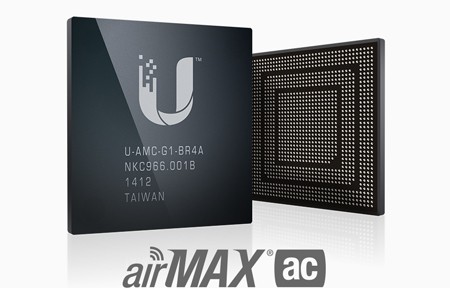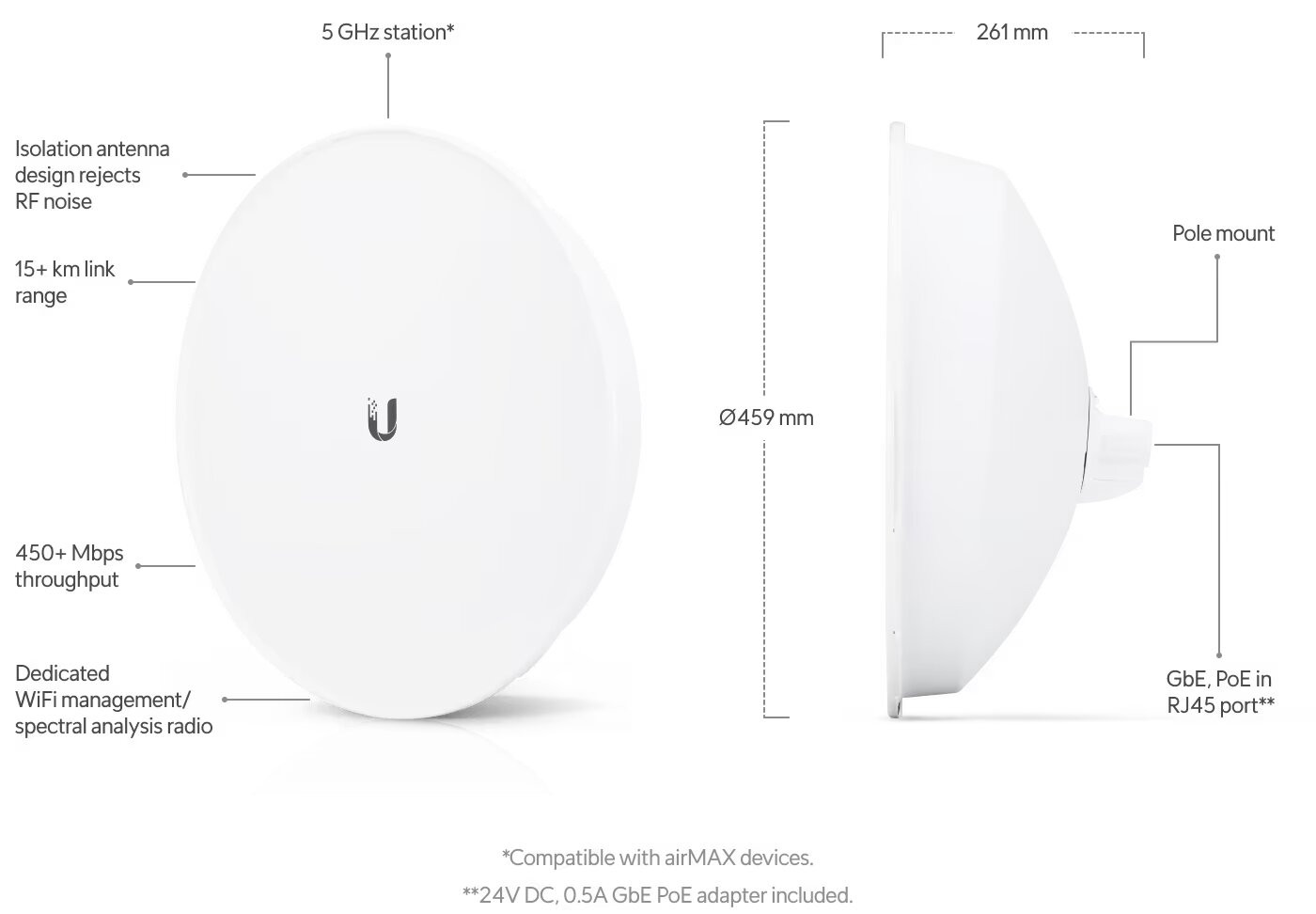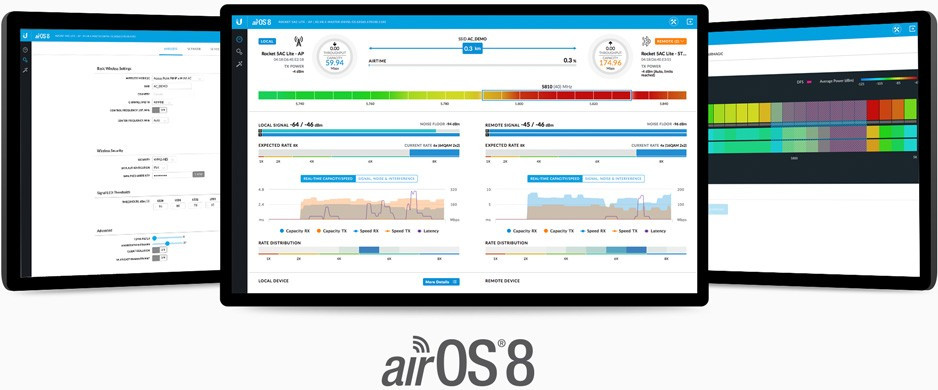5 GHz WiFi bridge with a 450+ Mbps Real TCP/IP throughput rate, 15+ km link range and enhanced surge protection.
The airMAX PowerBeam 5AC ISO Gen2, carrying the model manufacture part number PBE-5AC-ISO-Gen2, is an innovative and highly sophisticated wireless networking device from Ubiquiti Networks, designed to provide superior point-to-point (PtP) and point-to-multipoint (PtMP) connectivity. Operating in the 5 GHz frequency band, this device is equipped with Ubiquiti's advanced airMAX ac technology, which optimizes bandwidth efficiency and reduces latency, thereby enhancing network performance for high-speed wireless connectivity over extended distances.

This product should be purchased in pairs in order to form links.
The PBE-5AC-ISO-Gen2 is fully compatible with other devices in the airMAX ac series. This includes both base stations and CPE devices that operate on the 5 GHz frequency, enabling efficient and high-capacity wireless connections for PtP (Point-to-Point) and PtMP (Point-to-Multipoint) configurations. However, it’s important to note that while the PowerBeam 5AC ISO Gen2 is optimized for use within the airMAX ecosystem, direct interoperability with the UniFi series, which is tailored for managed indoor Wi-Fi networking and operates through the UniFi Controller, is not inherent due to the differing technologies and operational frameworks of the two series.
Central to the PowerBeam 5AC ISO Gen2's design is its integrated IsoBeam shield, an RF isolation technology that significantly minimizes interference from other signals in congested environments. This technology, coupled with the device's 25 dBi high-gain antenna, ensures focused and reliable wireless connections by directing the signal more precisely towards the target receiver. Such targeted signal transmission is vital in maintaining the integrity and quality of the network connection, especially in areas where the wireless spectrum is heavily utilized. Compare in a picture below the two near-field plots, and note the superior performance of the integrated RF isolator. Both near-field plots are displayed in watts and use a linear scale.

The PowerBeam 5AC ISO Gen2 boasts a robust dish reflector design with a diameter that enhances its capability to concentrate radio energy. This feature allows for longer-range connections with improved signal strength, making the device particularly well-suited for applications requiring robust, long-distance wireless links. The integration of the IsoBeam shield with the antenna further amplifies the device's performance by providing additional protection against interference, thereby ensuring a cleaner signal path.

Moreover, Ubiquiti's airMAX® engine with custom IC dramatically improves TDMA latency and network scalability. The custom silicon provides hardware acceleration capabilities to the airMAX scheduler, to support the high data rates and dense modulation used in airMAX ac technology.
Equipped with a dedicated mounting bracket, the PowerBeam 5AC ISO Gen2 is designed for ease of installation and precise alignment. This mounting solution enables network operators to quickly deploy the device and achieve optimal positioning for the best signal reception and transmission, a crucial aspect of maximizing network performance.
Durability is a key aspect of the PowerBeam 5AC ISO Gen2's design, featuring an all-weather enclosure that safeguards the device against harsh environmental conditions. This ensures sustained operation and reliability in diverse deployment scenarios, from rural to urban settings, across various climatic conditions.
Furthermore, the PowerBeam 5AC ISO Gen2 supports WPA2 encryption, ensuring that data transmitted across the network is secure and protected against unauthorized access. This level of security is paramount for maintaining the confidentiality and integrity of sensitive information communicated over the wireless network.
The device is managed through Ubiquiti's intuitive airOS software, which provides an extensive suite of tools for device configuration, network management, and performance analytics. airOS enables network administrators to fine-tune network parameters, access real-time data, and monitor system status to ensure optimal operation of the wireless network.
Choosing the right PowerBeam
Selecting the right PowerBeam product from Ubiquiti for your network involves a nuanced understanding of your specific needs and environmental conditions. Consider the frequency band: 2.4 GHz models like the PBE-2AC-400 and PBE-M2-400 are adept at penetrating obstacles and are suitable for medium-range deployments, while 5 GHz models, including PBE-5AC-Gen2, PBE-5AC-500, PBE-5AC-620, and PBE-5AC-ISO-Gen2, offer higher throughput and are ideal for clearer, longer-range links. The choice between these depends on the balance between range, throughput, and environmental factors such as different urban / natural obstacles and interference.
Antenna size directly influences range and signal focus: larger dishes on the PBE-5AC-500 and PBE-5AC-620 support the longest distances, whereas the PBE-5AC-Gen2 provides versatile deployment options. The PBE-5AC-ISO-Gen2's enhanced noise isolation makes it perfect for high-interference environments. Lastly, deployment scenarios—whether seeking broad coverage for multiple locations or a focused beam for direct point-to-point links—will guide your selection. Budget considerations and future scalability also play crucial roles in determining the most cost-effective and performance-optimized choice for your wireless network infrastructure.
Compare with similar products
| | | | | | |
|---|
| Wireless Standard | |
| |
| 802.11ac
| 802.11ac
| 802.11ac
| 802.11ac
| 802.11ac
|
| 2.4GHz Radio Rate | |
| |
| 450 Mbps
|
| 450 Mbps
| 450 Mbps
|
| 5GHz Radio Rate | |
| |
| 450 Mbps
|
| 450 Mbps
|
|
|
| Wireless Antenna Frequency Range & Gain | |
| |
| 5.150 - 5.875 (GHz) 25 (dBi)
| 2.412 - 2.472 (GHz) 18 (dBi)
| 5.150 - 5.875 (GHz) 25 (dBi)
| 5.150 - 5.875 (GHz) 27 (dBi)
| 5.150 - 5.875 (GHz) 29 (dBi)
|
| Antenna range | |
| |
| 15 km
| 25 km
| 15 km
| 25 km
| 25 km
|
| Ethernet Ports | |
| |
| 1 x 1 Gbps
| 1 x 1 Gbps
| 1 x 1 Gbps
| 1 x 1 Gbps
| 1 x 1 Gbps
|
| Chipset | |
| |
| MIPS 74Kc
| MIPS 74Kc
| MIPS 74Kc
| Atheros MIPS 74Kc, 720 MHz
| Atheros MIPS 74Kc, 720 MHz
|
| RAM | |
| |
| 64 MB
| 64 MB
| 64 MB
| 128 MB
| 128 MB
|
| Storage Memory | |
| |
|
|
| 16 MB
| 16 MB
|
| Max Power Consumption | |
| |
| 8.5 W
| 7.5 W
| 8.5 W
| 8.5 W
| 8.5 W
|
| Weight | |
| |
| 3.22 kg
| 1.795 kg
| 2.22 kg
| 3.15 kg
| 6.4 kg
|
| | | | | | |
|---|
| Wireless Standard | 802.11ac
| 802.11ac
| 802.11ac
| 802.11ac
| 802.11ac
|
| 2.4GHz Radio Rate |
| 450 Mbps
|
| 450 Mbps
| 450 Mbps
|
| 5GHz Radio Rate | 450 Mbps
|
| 450 Mbps
|
|
|
| Wireless Antenna Frequency Range & Gain | 5.150 - 5.875 (GHz) 25 (dBi)
| 2.412 - 2.472 (GHz) 18 (dBi)
| 5.150 - 5.875 (GHz) 25 (dBi)
| 5.150 - 5.875 (GHz) 27 (dBi)
| 5.150 - 5.875 (GHz) 29 (dBi)
|
| Antenna range | 15 km
| 25 km
| 15 km
| 25 km
| 25 km
|
| Ethernet Ports | 1 x 1 Gbps
| 1 x 1 Gbps
| 1 x 1 Gbps
| 1 x 1 Gbps
| 1 x 1 Gbps
|
| Chipset | MIPS 74Kc
| MIPS 74Kc
| MIPS 74Kc
| Atheros MIPS 74Kc, 720 MHz
| Atheros MIPS 74Kc, 720 MHz
|
| RAM | 64 MB
| 64 MB
| 64 MB
| 128 MB
| 128 MB
|
| Storage Memory |
|
|
| 16 MB
| 16 MB
|
| Max Power Consumption | 8.5 W
| 7.5 W
| 8.5 W
| 8.5 W
| 8.5 W
|
| Weight | 3.22 kg
| 1.795 kg
| 2.22 kg
| 3.15 kg
| 6.4 kg
|
Technical Specs / Datasheet





Reviews and ratings
Product rating